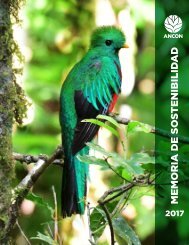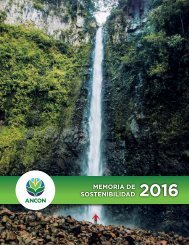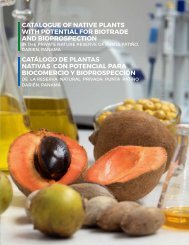Create successful ePaper yourself
Turn your PDF publications into a flip-book with our unique Google optimized e-Paper software.
34<br />
PRIVATE NATURE RESERVE OF PUNTA PATIÑO DARIEN, PANAMA<br />
RESERVA NATURAL PRIVADA PUNTA PATIÑO DARIÉN, PANAMÁ<br />
Attalea butyracea<br />
(Mutis ex L. f.) Wess. Boer<br />
Common name: Palma real<br />
Synonyms: Attalea humboldtiana, A. pycnocarpa,<br />
A. rostrata, A. wallisii, Cocos butyracea, Scheelea<br />
brachyc<strong>la</strong>da, S. butyracea, S. costaricensis, S.<br />
humboldtiana, S. liebmannii, S. macrolepis, S. passargei,<br />
S. rostrata, S. wallisii, S. zonensis<br />
Botanical family: Arecaceae (Palm family)<br />
Other names: Corozo, manaca, gunzo, palma canalera<br />
(Pan), pal<strong>la</strong> (Bol.), jací (Bra.), palma <strong>de</strong> vino (Col.),<br />
canambo (Ecu.), coquito (Gua.), coyol real (Mex.),<br />
hebon (Per.), palma <strong>de</strong> agua, yagua (Ven.).<br />
Description: Trees of medium height of up to 20<br />
meters high, with a thick trunk. Large vertically-oriented<br />
leaves. The flowers are white and appear in<br />
<strong>la</strong>rge bunches of over one meter long. The fruits are<br />
medium-sized, oval, and yellowish-orange in color as<br />
they ripen. The seeds are b<strong>la</strong>ck and elongated, with<br />
small grooves.<br />
Distribution: The trees are found in the less-arid<br />
parts of the <strong>Patiño</strong> Reserve. They are frequently<br />
found in the moist low<strong>la</strong>nds of the Pacific coast and<br />
in central Panama, often in forests and pasture <strong>la</strong>nd.<br />
This palm tree is wi<strong>de</strong>ly found from Southern Mexico<br />
through Peru and Bolivia.<br />
Phenology: The tree flowers from April to July, and<br />
the fruits mature from March to September.<br />
Nombre común: Palma real<br />
Sinónimos: Attalea humboldtiana, A. pycnocarpa,<br />
A. rostrata, A. wallisii, Cocos butyracea, Scheelea<br />
brachyc<strong>la</strong>da, S. butyracea, S. costaricensis, S.<br />
humboldtiana, S. liebmannii, S. macrolepis, S. passargei,<br />
S. rostrata, S. wallisii, S. zonensis<br />
Familia botánica: Arecaceae (familia <strong>de</strong> <strong>la</strong>s palmas)<br />
Otros nombres: Corozo, manaca, gunzo, palma canalera<br />
(Pan), pal<strong>la</strong> (Bol.), jací (Bra.), palma <strong>de</strong> vino (Col.),<br />
canambo (Ecu.), coquito (Gua.), coyol real (Méx.),<br />
hebon (Per.), palma <strong>de</strong> agua, yagua (Ven.).<br />
Descripción: Árbol mediano <strong>de</strong> hasta 20 metros <strong>de</strong><br />
altura y tronco grueso. Las hojas son gran<strong>de</strong>s y se<br />
disponen en un p<strong>la</strong>no vertical. Las flores son b<strong>la</strong>ncas,<br />
agrupadas en un racimo gran<strong>de</strong>, <strong>de</strong> más <strong>de</strong> un<br />
metro <strong>de</strong> <strong>la</strong>rgo. Los frutos son <strong>de</strong> tamaño mediano,<br />
ova<strong>la</strong>dos y <strong>de</strong> color naranja amarillento al madurar.<br />
Las semil<strong>la</strong>s son negras, a<strong>la</strong>rgadas, <strong>con</strong> pequeños<br />
surcos.<br />
Distribución: En <strong>Patiño</strong>, se localiza en <strong>la</strong>s partes<br />
menos secas <strong>de</strong> <strong>la</strong> reserva. Es frecuente en <strong>la</strong>s áreas<br />
húmedas <strong>de</strong> <strong>la</strong>s tierras bajas <strong>de</strong> <strong>la</strong> costa <strong>de</strong>l Pacífico<br />
y <strong>la</strong> parte central <strong>de</strong> Panamá, don<strong>de</strong> se pue<strong>de</strong> en<strong>con</strong>trar<br />
en potreros y bosques. Es una palma <strong>de</strong> amplia<br />
distribución, que abarca <strong>de</strong>s<strong>de</strong> el sur <strong>de</strong> México hasta<br />
Perú y Bolivia.<br />
Fenología: Florece <strong>de</strong>s<strong>de</strong> abril hasta junio y los frutos<br />
maduran <strong>de</strong>s<strong>de</strong> marzo a septiembre.








